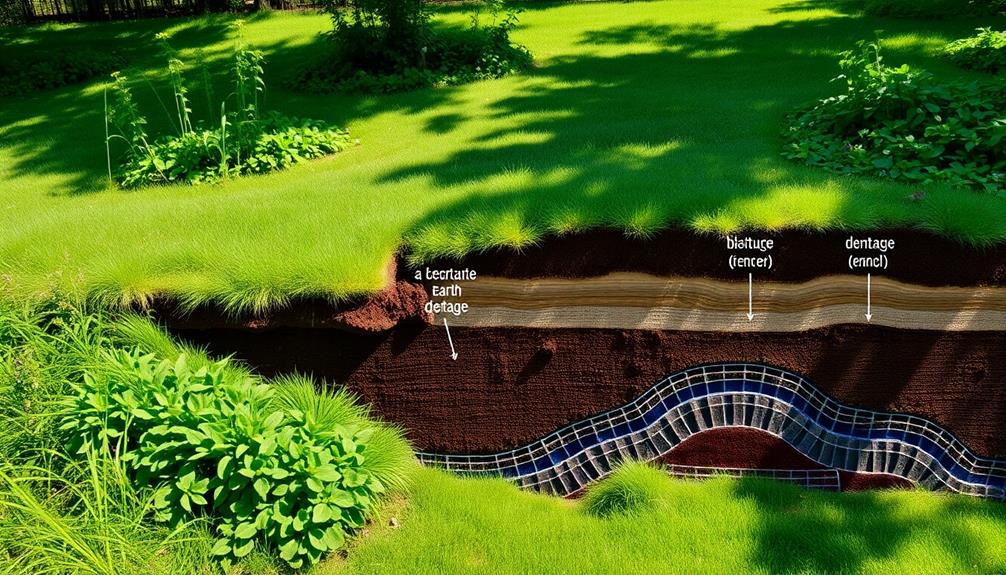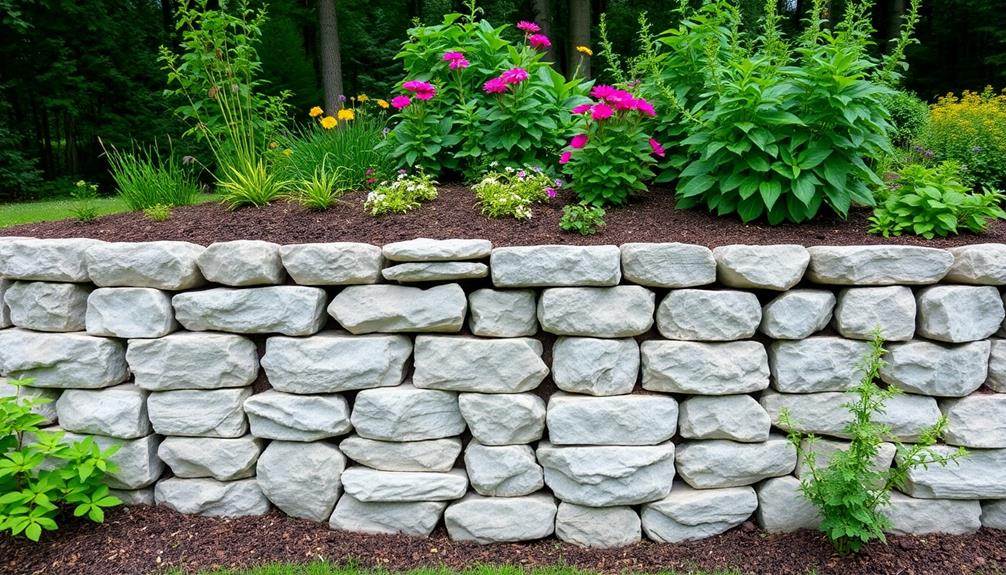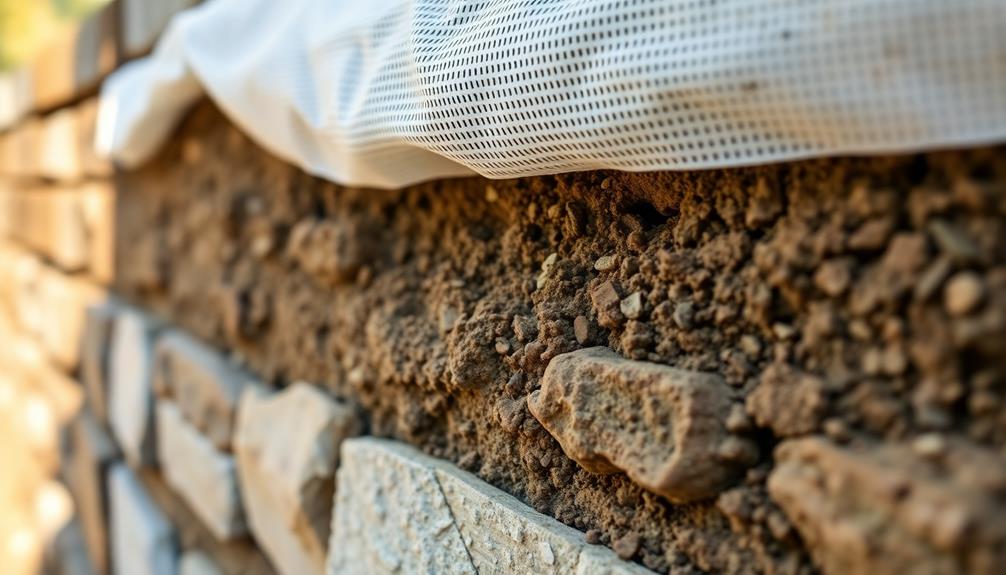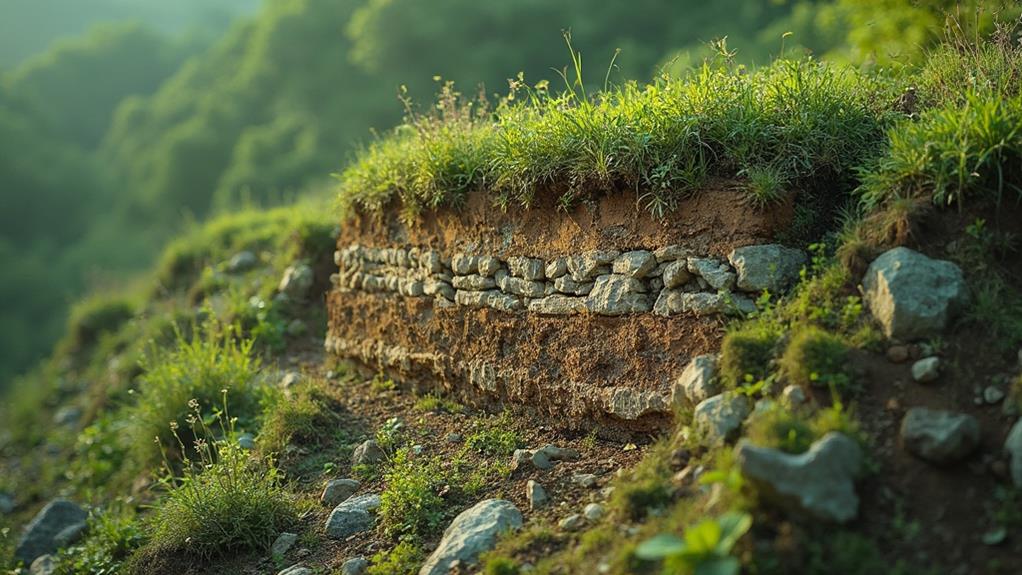When constructing retaining walls, pivotal considerations include soil properties and drainage systems. The soil's texture, compaction, and moisture content drastically impact wall stability, with sandy soils offering better drainage and clay posing lateral pressure challenges. Adequate drainage, achieved through techniques like weep holes or perforated pipes, mitigates hydrostatic pressure and enhances structural integrity. Incorporating geotextiles for soil reinforcement can prevent erosion and guarantee load distribution. Understanding soil moisture retention and employing effective water management practices protect the structure from instability and collapse. Exhaustive knowledge of soil and drainage factors facilitates the design of resilient and durable retaining walls, opening deeper insights.
Table of Contents
ToggleWalls Contractor Highlights
- Evaluate soil characteristics, including texture, compaction, and moisture content, to ensure retaining wall performance and stability.
- Implement effective drainage systems, such as weep holes or perforated pipes, to prevent hydrostatic pressure build-up.
- Select soil types with low moisture retention to minimize weight and pressure against the retaining wall.
- Use geotextiles to reinforce soil stability, prevent erosion, and enhance water filtration behind the wall.
- Assess load-bearing capacity by analyzing soil strength, cohesion, and internal friction to ensure a solid foundation.
Soil's Role in Walls

The characteristics of soil play a critical role in the stability and effectiveness of retaining walls, primarily through its type, load-bearing capacity, and moisture retention properties. Different soil types, such as clay, sand, or silt, have varying impacts on how a wall must be engineered to withstand potential pressures and displacement.
Additionally, boulder retaining walls are designed to hold soil in place over the long term, providing a durable and cost-effective solution. Consequently, the soil's ability to retain water greatly influences its weight and, consequently, the stress exerted on the structure, underscoring the importance of selecting appropriate drainage solutions to maintain the wall's integrity.
Soil Type Impact
Different types of soil substantially influence the structural integrity and longevity of retaining walls. The soil's inherent properties, such as texture, grain size, compaction, and moisture content, play indispensable roles in retaining wall performance.
Sand, for instance, tends to provide good drainage and reduced hydrostatic pressure against the wall, fostering stability over time. However, its coarse texture requires additional consideration for compaction, which can impact overall wall support if not managed properly.
Clay, by contrast, presents distinctive challenges. Its fine particles increase susceptibility to water retention, leading to expansion upon saturation and contraction when dry. Such fluctuations result in significant lateral pressure against the wall structure, potentially compromising integrity without proper reinforcement. Additionally, clay's low permeability can exacerbate drainage issues, necessitating meticulous design solutions to mitigate these potential drawbacks.
Silty soils, though less commonly encountered, exhibit characteristics between those of sand and clay. They possess moderate drainage abilities but can still pose challenges related to fluctuating water content. Understanding each soil type's nuances inspires better wall design and construction practices, promoting a sense of trust and community among builders and clients alike. As projects proceed, selecting appropriate soil stabilization and drainage strategies is essential, underscoring the importance of careful assessment and expert consultation.
Load-Bearing Capacity
Understanding soil type deeply influences not only drainage considerations but also the load-bearing capacity crucial for retaining wall stability. Recognizing the pivotal role that soil plays assists in ensuring walls are built to withstand varying forces and pressures encountered in different environments. The interaction between soil characteristics and structural requirements leads to a balanced approach toward wall design.
Soil Strength: The inherent strength of the soil is a primary consideration. Different soils exert varied resistance, impacting how much weight a retaining wall can safely support without risk of failure.
Compaction Level: A well-compacted soil base provides a solid foundation, directly enhancing load-bearing strength and ensuring uniform pressure distribution under the wall.
Cohesion and Friction Mechanics: Soil cohesion and internal friction affect stability immensely. Cohesive soils may hold together under load, whereas friction relies on particle interlocking—each affecting wall integrity.
Drainage and Soil Pressure: Even without exploring moisture retention effects, it's essential to note that clay or silt soils under pressure exert different forces on a wall compared to granular soils, directly influencing load distribution.
Ultimately, understanding these factors fosters a knowledgeable community empowered with the insights necessary for constructing safe and durable retaining walls.
Moisture Retention Effects
Amid varying environmental conditions, moisture retention in soil serves as a critical factor influencing the long-term stability and performance of retaining walls. The interaction between soil and water determines the structural integrity of these walls, as excess moisture increases the soil's weight and hydraulic pressure against the wall. This added stress can lead to undesirable consequences such as excessive pressure, wall tilting, or even collapse.
Proper assessment of soil properties including texture, porosity, and drainage capacity is essential for designing retaining walls that rehabilitate these concerns.
For communities engaged in developing durable retaining wall systems, understanding moisture retention effects is integral. The adoption of permeable materials and inclusion of well-designed drainage systems can mitigate moisture accumulation. Implementing drainage solutions such as weep holes, gravel backfill, and geo-synthetic textiles are critical to achieving effective water management.
Together, these practices help reduce unwanted water retention, thereby enhancing stability and extending the lifespan of retaining structures.
Moreover, professional soil analysis can reveal underlying concerns such as clay content, which retains moisture and swells, exacerbating pressure on the wall. By recognizing these factors, communities can create harmonized structures that fulfill both practical and aesthetic aspirations.
Benefits

The integration of effective soil and drainage systems in retaining walls offers significant benefits by enhancing water management and maintaining soil stability. Implementing versatile riprap solutions can further aid erosion control and extend the longevity of the retaining walls by naturally blending with the environment and requiring minimal maintenance.
This approach not only guarantees reduced risk of erosion, which can compromise structural integrity, but also contributes to increased longevity of the walls, safeguarding against premature deterioration. By addressing these critical factors, retaining walls can provide enduring performance and reliability.
Improved Water Management
How can improved water management enhance the longevity and functionality of retaining walls? The effective management of water plays a critical role in the durability and efficiency of these structures. Retaining walls, by their nature, are subjected to notable pressures from soil and water. Without proper water management, excessive moisture accumulation can undermine their integrity, leading to costly repairs and potential collapse. By implementing strategic water management practices, these risks can be substantially mitigated.
Consider the following benefits of improved water management:
- Reduced Hydrostatic Pressure: Efficient drainage systems alleviate the build-up of hydrostatic pressure behind the retaining wall, preventing structural stress and potential failure.
- Prevention of Soil Erosion: Effective water management controls the surface runoff, minimizing the erosion of base soils and ensuring the stability and security of the wall over time.
- Enhanced Durability: By directing water away from the structure efficiently, retaining walls experience less freeze-thaw cycles, which extends their lifespan and reduces maintenance needs.
- Improved Aesthetic and Environmental Integration: Proper water control not only supports the structure itself but integrates surroundings seamlessly, providing a visually pleasing design that complements the natural landscape, fostering a sense of harmony and connection.
Through these practical measures, retaining walls become more reliable and resilient.
Enhanced Soil Stability
Building upon the principles of improved water management, enhancing soil stability is another pivotal aspect of ensuring the longevity and functionality of retaining walls. A stable soil foundation mitigates the potential for structural compromise and reduces maintenance needs over time. The increased cohesion between soil particles contributes directly to the strength of the retaining wall structure, ultimately providing a more reliable and enduring boundary for terrain changes.
Methods such as soil compaction, reinforcement with geogrids, or the incorporation of soil binders can solidify the ground, creating a foundation capable of withstanding both everyday stress and unexpected environmental shifts.
For those engaging in constructing or maintaining retaining walls, the significance of soil stability extends beyond structural soundness. It fosters a sense of community amongst individuals who prioritize the safety and beauty of shared environments, offering a collective assurance that landscapes are both safe and stunning. Additionally, techniques that stabilize soil promote environmental harmony by preserving natural topographies and facilitating sustainable landscaping practices.
Reduced Erosion Risk
Mitigating erosion risk presents significant benefits for the sustainability and integrity of retaining walls. Erosion is a natural process that can dramatically undermine the structural capacity and reliability of retaining walls if not properly managed. Effective soil and drainage systems are pivotal in reducing erosion, offering several key advantages that underscore their importance in construction and landscaping projects.
Enhanced Structural Stability: Proper drainage reduces hydrostatic pressure against the wall, thereby decreasing the risk of soil saturation and slippage that could compromise wall stability.
Minimized Repair Costs: By preventing soil erosion, retaining wall systems require fewer repairs, avoiding costly interventions and prolonging their function without frequent maintenance.
Environmental Preservation: Effective erosion control measures help in preserving the surrounding landscape and protecting local ecosystems from degradation caused by uncontrolled water flow.
Increased Safety: Reducing erosion lowers the potential for hazardous conditions, such as landslides or collapse, ensuring that landscapes and infrastructure remain safe for communities.
Increased Wall Longevity
A well-designed soil and drainage system greatly contributes to the increased longevity of retaining walls, which is a substantial benefit in both residential and commercial settings. By efficiently managing water accumulation and pressure, these systems safeguard the structural integrity of retaining walls, preventing premature deterioration. Water is a persuasive adversary to any constructed wall; extensive saturation can compromise its core supports, leading to failures.
Implementing effective drainage, such as weep holes or perforated pipes, alleviates hydrostatic pressure by directing water away from the wall, thereby prolonging its lifespan.
Moreover, the strategic selection and placement of appropriate soil are essential. Cohesive soils, which possess fine particles, inherently retain water and can escalate pressure during heavy rainfall. Instead, integrating free-draining granular materials, like gravel or sand behind the wall, guarantees rapid water movement, reducing the stress on the structure. This thoughtful integration of proper soil types not only boosts wall longevity but also reflects a commitment to sustainable building practices.
In the shared pursuit of enduring, reliable infrastructure, understanding and implementing advanced soil and drainage systems allows communities to foster spaces that symbolize resilience and long-term coexistence with nature's constraints, contributing to an enduring sense of security and unity.
Geotextile Usage for Stability

Geotextiles are integral components in the construction of retaining walls, offering substantial benefits for enhancing soil reinforcement, preventing soil erosion, and improving water filtration. These specialized fabrics work by stabilizing the soil structure and controlling water flow, thereby maintaining the integrity of the wall and surroundings. Below is a concise summary of the purposes and advantages of geotextile usage:
| Purpose | Advantage |
|---|---|
| Soil Reinforcement | Boosts overall stability and load-bearing capacity |
| Erosion Prevention | Minimizes soil displacement and degradation |
| Water Filtration | Enhances drainage by allowing water to pass through |
| Structural Integrity | Preserves long-term coherence of the retaining system |
Enhancing Soil Reinforcement
Soil reinforcement is a critical aspect in the construction of retaining walls, particularly for guaranteeing long-term stability and durability. One of the highly effective methods for enhancing soil reinforcement involves the use of geotextiles. These synthetic materials, often made from polymers like polyester or polypropylene, are integral in providing stability and durability.
Geotextiles serve as reinforcements by interlocking with the fill material and providing additional tensile strength to the soil structure, preventing subsidence and shifting that might otherwise compromise the wall's integrity.
In implementing geotextiles effectively, consider the following guidelines:
- Material Selection: Choose geotextiles with appropriate tensile strength and permeability to suit specific soil conditions and project requirements. The right choice guarantees compatibility and longevity.
- Layering Strategy: Strategically place geotextile layers within the soil to encourage uniform load distribution and enhance performance, which can fortify the entire structure.
- Installation Precision: Ensure meticulous installation to avoid wrinkles or misalignments, which can reduce the intended structural benefits.
- Quality Control: Regular inspection and maintenance are essential to address any wear or damage, guaranteeing the geotextiles continue to perform their duty over the structure's lifespan.
Preventing Soil Erosion
Effective erosion prevention elevates the stability of retaining walls and guarantees their longevity. The application of geotextiles plays a pivotal role in this process, providing structural reinforcement by preventing soil from eroding while enhancing overall stability. Geotextiles, typically constructed from polypropylene or polyester, create a permeable barrier that stabilizes the soil, effectively anchoring it in place. These fabrics allow for water filtration, yet they prevent finer soil particles from being displaced, which is imperative for maintaining the integrity of retaining structures.
Incorporating geotextiles in retaining walls embodies an innovative approach that ensures the wall's design remains both functional and aesthetically pleasing over time. These materials are versatile, offering adaptability to diverse environmental conditions and enabling customized solutions to unique erosion challenges. By integrating geotextiles, the risk of soil erosion is considerably minimized, fostering a sense of security and belonging among communities reliant on these structures' performance.
Moreover, geotextiles aid in distributing loads evenly, reducing differential settlement that can lead to wall failure. By promoting uniformity in load-bearing capacity, geotextiles serve as an unseen yet essential component for those invested in sustainable and secure landscape design.
Improving Water Filtration
Some innovative approaches for improving water filtration in retaining walls involve the strategic use of geotextiles. These permeable fabrics allow the passage of water while retaining soil, playing a pivotal role in enhancing the stability and longevity of retaining walls. Geotextiles can be an integral part of an efficient drainage solution by managing subsurface water flow and preventing soil erosion. Their application underscores the importance of using advanced materials to achieve ideal soil and drainage management, ensuring that the retaining walls remain structurally sound over time.
Effective geotextile usage can be achieved by adhering to key considerations and techniques:
- Material Compatibility: Select geotextiles that are compatible with the soil type and other construction materials used in the retaining wall project. This consideration is fundamental for ensuring the long-term functionality of the drainage system.
- Proper Placement: To maximize water filtration effectiveness, geotextiles should be strategically positioned between the soil and drainage materials, aiding in the prevention of soil migration.
- Layering Techniques: Employing multiple geotextile layers can enhance filtration efficiency, particularly in areas prone to high water flow and soil erosion.
- Regular Inspection: Schedule consistent maintenance checks to ensure geotextiles remain effective and functional, safeguarding the structural integrity of the retaining wall.
Walls Contractor FAQ
How Does Climate Affect the Choice of Soil for Retaining Walls?
Climate greatly influences soil selection for retaining walls by dictating moisture levels and temperature changes. Appropriate soil choice guarantees wall stability and durability, fostering a shared commitment to endurance and harmony with environmental conditions among construction professionals.
What Type of Maintenance Is Required for Drainage Systems in Retaining Walls?
To maintain drainage systems in retaining walls, guarantee regular inspections to identify blockages, clean debris from drains, and check pipes for damage. Such collective efforts safeguard community structures, fostering stability and unity in shared spaces.
How Can Erosion Impact the Effectiveness of Retaining Walls?
Erosion undermines retaining wall stability by wearing away essential support materials. This weakens structural integrity, potentially leading to failure. Understanding erosion's effects fosters solidarity in prevention efforts, ensuring long-lasting, effective retaining walls for our communities and their environments.
Are There Specific Plants That Can Help With Soil Stability in Retaining Walls?
Incorporating plants such as creeping junipers, ornamental grasses, or sedums can enhance soil stability in retaining walls. These species foster a sense of community among gardeners by minimizing erosion, creating visual appeal, and strengthening the wall structures collectively.
What Are the Potential Signs of Drainage Issues in Existing Retaining Walls?
Signs of drainage issues in retaining walls may include visible water stains, efflorescence, soil erosion, bowing or tilting of the wall, cracks, and pooling water at the base. Timely detection guarantees community safety and structural integrity.







